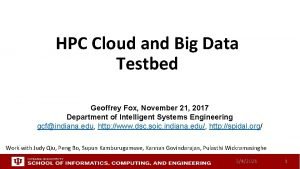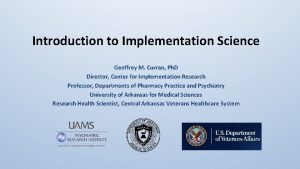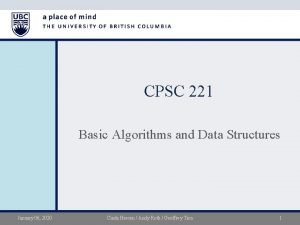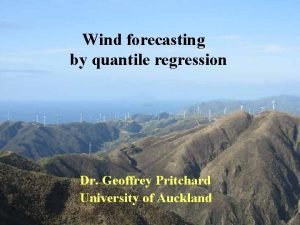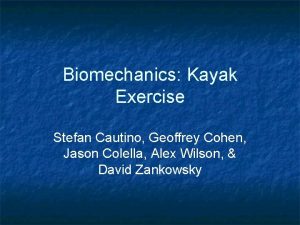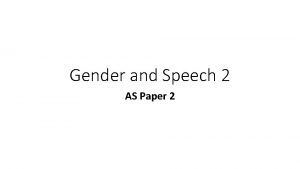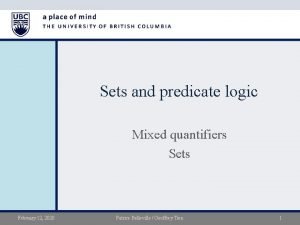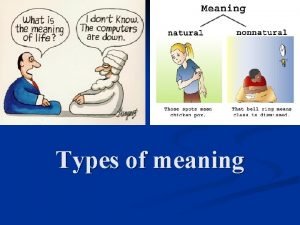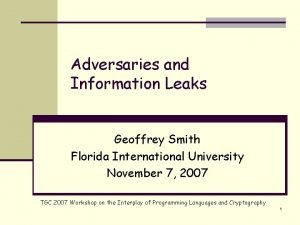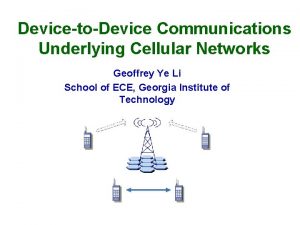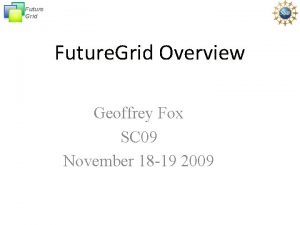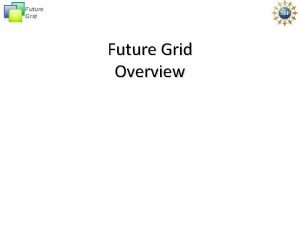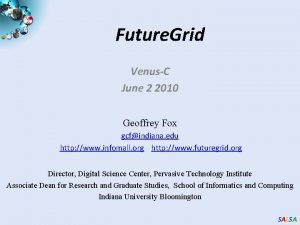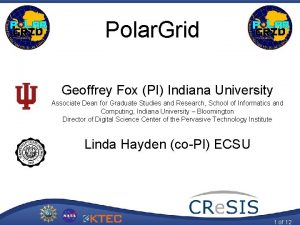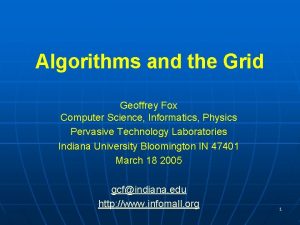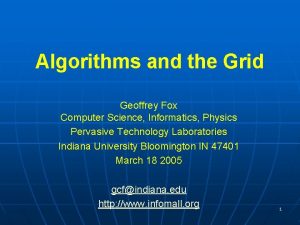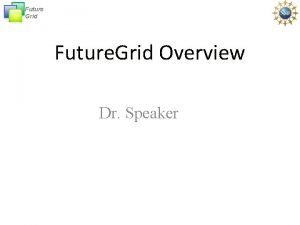Future Grid Future Grid Overview Geoffrey Fox gcfindiana

















- Slides: 17

Future Grid Future. Grid Overview Geoffrey Fox gcf@indiana. edu www. infomall. org School of Informatics and Computing and Community Grids Laboratory, Digital Science Center Pervasive Technology Institute Indiana University

Future Grid Future. Grid • The goal of Future. Grid is to support the research on the future of distributed, grid, and cloud computing. • Future. Grid will build a robustly managed simulation environment or testbed to support the development and early use in science of new technologies at all levels of the software stack: from networking to middleware to scientific applications. • The environment will mimic Tera. Grid and/or general parallel and distributed systems – Future. Grid is part of Tera. Grid and one of two experimental Tera. Grid systems (other is GPU) • This test-bed will succeed if it enables major advances in science and engineering through collaborative development of science applications and related software. • Future. Grid is a (small 5600 core) Science Cloud but it is more accurately a virtual machine based simulation environment

Future Grid Future. Grid Hardware

Future Grid Future. Grid Hardware • Future. Grid has dedicated network (except to TACC) and a network fault and delay generator • Can isolate experiments on request; IU runs Network for NLR/Internet 2 • (Many) additional partner machines will run Future. Grid software and be supported (but allocated in specialized ways)

Future Grid Future. Grid Partners • Indiana University (Architecture, core software, Support) • Purdue University (HTC Hardware) • San Diego Supercomputer Center at University of California San Diego (INCA, Monitoring) • University of Chicago/Argonne National Labs (Nimbus) • University of Florida (Vi. NE, Education and Outreach) • University of Southern California Information Sciences Institute (Pegasus to manage experiments) • University of Tennessee Knoxville (Benchmarking) • University of Texas at Austin/Texas Advanced Computing Center (Portal) • University of Virginia (OGF, Advisory Board and allocation) • Center for Information Services and GWT-TUD from Technische Universtität Dresden. (VAMPIR) • Blue institutions have Future. Grid hardware

Future Grid Other Important Collaborators • NSF • Early users from an application and computer science perspective and from both research and education • Grid 5000/Aladin and D-Grid in Europe • Commercial partners such as – Eucalyptus …. – Microsoft (Dryad + Azure) – Note current Azure external to Future. Grid as are GPU systems – Application partners • Tera. Grid • Open Grid Forum • ? Open Nebula, Open Cirrus Testbed, Open Cloud Consortium, Cloud Computing Interoperability Forum. IBM-Google-NSF Cloud, UIUC Cloud?

Future Grid Future. Grid Architecture

Future Grid Future. Grid Architecture • Open Architecture allows to configure resources based on images • Managed images allows to create similar experiment environments • Experiment management allows reproducible activities • Through our modular design we allow different clouds and images to be “rained” upon hardware. • Note will be supported 24 x 7 at “Tera. Grid Production Quality” • Will support deployment of “important” middleware including Tera. Grid stack, Condor, BOINC, g. Lite, Unicore, Genesis II

Future Grid Future. Grid Usage Scenarios • Developers of end-user applications who want to develop new applications in cloud or grid environments, including analogs of commercial cloud environments such as Amazon or Google. – Is a Science Cloud for me? • Developers of end-user applications who want to experiment with multiple hardware environments. • Grid/Cloud middleware developers who want to evaluate new versions of middleware or new systems. • Networking researchers who want to test and compare different networking solutions in support of grid and cloud applications and middleware. (Some types of networking research will likely best be done via through the GENI program. ) • Education as well as research • Interest in performance requires that bare metal important

Future Grid Typical (simple) Example • Evaluate usability and performance of Clouds and Cloud Technologies on biology applications • Hadoop (on Linux) v Dryad (on Windows) or Sector v MPI v “Nothing (worker nodes)” (on Linux or Windows) on – Bare Metal or – Virtual Machines (of various types) • Future. Grid supports rapid configuration of hardware and core software to enable such reproducible experiments

Future Grid Alu Sequencing Workflow • Data is N sequences – ~300 characters (A, C, G, and T) long – These cannot be thought of as vectors because there are missing characters – “Multiple Sequence Alignment” (creating vectors of characters) doesn’t seem to work if N larger than O(100) • First calculate N 2 dissimilarities (distances) between sequences (all pairs) in Dryad Hadoop or MPI • Find families by clustering (using much better methods than Kmeans). As no vectors, use vector free O(N 2) methods • Map to 3 D for visualization by O(N 2) Multidimensional Scaling MDS • N = 50, 000 runs in 10 hours (all above) on 768 cores • Our collaborators just gave us 170, 000 sequences and want to look at 1. 5 million – will develop new “fast multipole” algorithms! • MDS/Clustering need MPI (just Barrier, Reduce, Broadcast) or enhanced Map. Reduce – how general?

Future Grid Gene Family from Alu Sequencing 1250 million distances 4 hours & 46 minutes • Calculate pairwise distances for a collection of genes (used for clustering, MDS) • O(N^2) problem • “Doubly Data Parallel” at Dryad Stage • Performance close to MPI • Performed on 768 cores (Tempest Cluster) 20000 18000 Dryad. LINQ 16000 MPI 14000 12000 10000 8000 Processes work better than threads when used inside vertices 100% utilization vs. 70% 6000 4000 2000 0 35339 50000

Future Grid

Future Grid

Future Grid Dryad versus MPI for Smith Waterman Flat is perfect scaling

Future Grid Hadoop/Dryad Comparison Inhomogeneous Data 1800 Time Dryad 1700 1600 Hadoop 1500 Mean Length 400 1300 1200 0 50 100 150 200 250 300 350 Sequence Length Standard Deviation Dryad with Windows HPCS compared to Hadoop with Linux RHEL on Idataplex Both runs can be optimized further

Future Grid Selected Future. Grid Timeline • October 1 2009 Project Starts • November 16 -19 SC 09 Demo/F 2 F Committee Meetings/Chat up colalborators • January 2010 – Significant Hardware available • March 2010 Future. Grid network complete • March 2010 Future. Grid Annual Meeting • September 2010 All hardware (except Track IIC lookalike) accepted • October 1 2011 Future. Grid allocatable via Tera. Grid process – first two years by user/science board led by Andrew Grimshaw
 Geoffrey fox
Geoffrey fox Overview of grid architecture
Overview of grid architecture Grid computing introduction
Grid computing introduction Future perfect simple vs future perfect continuous
Future perfect simple vs future perfect continuous Sentence on future perfect continuous tense
Sentence on future perfect continuous tense Geoffrey curran
Geoffrey curran Prince royce background
Prince royce background Geoffrey hamilton unece
Geoffrey hamilton unece Cpsc 221 ubc
Cpsc 221 ubc Geoffrey pritchard
Geoffrey pritchard Dr geoffrey cohen
Dr geoffrey cohen Jane pilkington 1992
Jane pilkington 1992 Geoffrey hinton backpropagation
Geoffrey hinton backpropagation Performer heritage geoffrey chaucer
Performer heritage geoffrey chaucer Mixed quantifiers
Mixed quantifiers Geoffrey leech 7 types of meaning
Geoffrey leech 7 types of meaning Professor geoffrey smith fiu
Professor geoffrey smith fiu Geoffrey ye li
Geoffrey ye li
